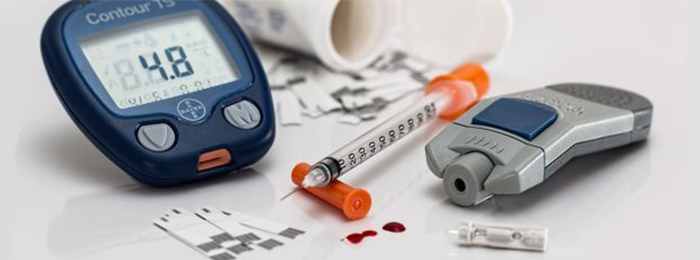Key Points:
- Insulin resistance (IR) is the decreased ability to respond to the effects of insulin.
- Insulin resistance is associated with Type 2 diabetes, cardiovascular disease, hypertension, polycystic ovarian syndrome, abdominal obesity, and nonalcoholic fatty liver disease
- Healthy lifestyle (proper diet and regular exercise) can help prevent insulin resistance.
What is Insulin resistance?
Insulin resistance (IR) is a condition with a decreased ability to respond to the effects of insulin, a hormone that is produced by the beta cells of the pancreas. Insulin resistance can be seen in the liver, muscle or adipose (fat) tissues. Insulin has many actions within the body including those involved in metabolism of carbohydrates (sugars and starches), fat and proteins. Since cells must have glucose to survive, the body compensates for insulin resistance by producing additional amounts of insulin. This results in higher levels of insulin [hyperinsulinemia] in the blood, which is one of the signs of insulin resistance.
Causes of Insulin Resistance
The underlying causes for the development of IR are not well defined, but both genetic factors and environmental factors such as excessive caloric intake and physical inactivity and obesity are considered important risk factors.
In most individuals, the body is able to keep pace with the need for extra insulin production, and hence not many undesirable side effects are seen. However when the body’s insulin production fails to keep up with demand, then hyperglycemia (high blood sugar) will occur, and over time it can progress to Type 2 diabetes. Insulin resistance usually has no specific symptoms, but if you have one or more of these conditions, you are advised to consult a physician.
- Obesity – especially around the abdomen
- Patches of dark and thickened skin, which has a velvety feel around the neck or on the back [Acanthosis nigricans]. Other possible sites for Acanthosis nigricans include elbows, knees, knuckles, and armpits
- Gestational diabetes mellitus [Diabetes occurring during pregnancy]
- Polycystic Ovarian Disease (PCOD) a condition due to hormonal imbalance that causes irregular periods, abnormal hair growth and acne in women
- High blood pressure, high blood triglycerides, low HDL (good) cholesterol
Associated conditions:
Insulin resistance is not a disease or a specific diagnosis by itself but it is associated with conditions such as Type 2 diabetes, cardiovascular disease, hypertension, polycystic ovarian syndrome, abdominal obesity [having excess weight around the waist], and nonalcoholic fatty liver disease. Additionally, insulin resistance is associated with increased levels of serum triglycerides, small dense LDL cholesterol and decreased levels of HDL (“good”) cholesterol. Clustering of these metabolic risk factors is called ‘Metabolic Syndrome’ or ‘Insulin Resistance Syndrome’ or formerly called ‘Syndrome X’.
The International Diabetes Federation [IDF] defines metabolic syndrome or insulin resistance syndrome as the presence of abdominal obesity plus two or more risk factors:
- Abdominal obesity- waist measurement of 90 cm or more for men and 80 cm or more for women in South Asians and specifically Indians
- Triglyceride levels of 150 milligrams per deciliter (mg/dL) or above, or taking medication for elevated triglyceride levels
- HDL, or “good,” cholesterol level below 40 mg/dL for men and below 50 mg/dL for women, or taking medication for low HDL levels
- Blood pressure levels of 130/85 or above, or taking medication for elevated blood pressure levels
- Fasting blood glucose levels of 100 mg/dL or above, or taking medication for elevated blood glucose levels
Management of Insulin resistance
Early recognition is important and interventions such as diet modification, physical activity and weight reduction are the cornerstones in managing insulin resistance. One should have a diet with a low carbohydrate, low glycaemic index, high fibre and low fat. Foods with high glycaemic index (GI), which indicates the glucose-raising effect of a food, should be restricted as they increase blood glucose levels more rapidly and require the secretion of more insulin to control the level of glucose in the blood. Regular exercise helps to lower blood glucose level, strengthen muscles, helps body cells to use insulin better and lower blood pressure. It has been shown that weight loss increases the rate at which glucose in the blood is utilized by muscle cells as a result of improved insulin sensitivity.
Medical treatment can be used as an adjunct to lifestyle modification but should be prescribed by a physician. Metformin helps to regulate the amount of sugar in the blood. It prevents the liver from releasing glucose into the blood, and it increases the sensitivity of muscle and fat cells to insulin.
To sum up, a healthy lifestyle (proper diet and regular exercise) can help prevent insulin resistance. These measures need to be adopted right from school or college days. Reducing or preventing insulin resistance can help to prevent not only diabetes, but also heart disease.





4 thoughts on “Insulin Resistance”
Excellent information sir ??
Excellent information sir ??